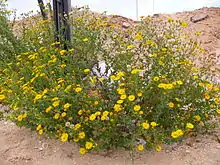Heterotheca subaxillaris
Heterotheca subaxillaris, known by the common name camphorweed,[2] is a North American species of flowering plant in the family Asteraceae.[3] It is widespread across much of the United States (from California to Massachusetts) as well as Mexico and Belize.[4][5]
| Heterotheca subaxillaris | |
|---|---|
 | |
| Scientific classification | |
| Kingdom: | Plantae |
| Clade: | Tracheophytes |
| Clade: | Angiosperms |
| Clade: | Eudicots |
| Clade: | Asterids |
| Order: | Asterales |
| Family: | Asteraceae |
| Genus: | Heterotheca |
| Species: | H. subaxillaris |
| Binomial name | |
| Heterotheca subaxillaris | |
| Synonyms[1] | |
|
Synonymy
| |
Heterotheca subaxillaris is a perennial, aromatic herb up to 203 centimeters (80 inches or 6 2/3 feet) in height, often with several erect stems. The stems are hairy to bristly. The inflorescence contains 3-180 flower heads in a flat-topped array. Each head contains 15–35; yellow ray florets surrounding 25–60 disc florets at the center.[6]
Chemistry
The leaf volatiles from which the name "camphorweed" is derived include camphor, but as a minor constituent (less than 2%); of 41 documented volatiles, for example, caryophyllene, pinene, borneol, myrcene, and limonene each comprised over 5% of the total.[7]
References
- The Plant List, Heterotheca subaxillaris (Lam.) Britton & Rusby
- USDA, NRCS (n.d.). "Heterotheca subaxillaris". The PLANTS Database (plants.usda.gov). Greensboro, North Carolina: National Plant Data Team. Retrieved 21 July 2015.
- Discover Life, Heterotheca subaxillaris (Lam. ) Britton &. Rusby, camphorweed
- SEINet, Southwestern Biodiversity, Arizona chapter photos, description, partial distribution map
- Biota of North America Program 2014 county distribution map
- Flora of North America, Heterotheca subaxillaris (Lamarck) Britton & Rusby, 1887.
- Lincoln, D.E., B.M. Lawrence. 1984. The volatile constituents of camphorweed, Heterotheca subaxillaris. Phytochemistry 23(4):933-934
